NORTH WALES COAST
RAILWAY: NOTICE BOARD
Rheilffordd arfordir gogledd Cymru: Hysbysfwrdd
21 June 2010
 Last issue
Last issue Archive
Archive Contributions and comments are encouraged: see the Contributions Page
This site is dedicated to all our regular contributors and supporters, and especially the all rail staff of North Wales.
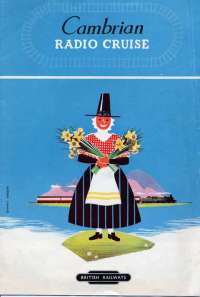
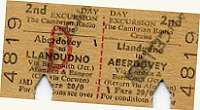
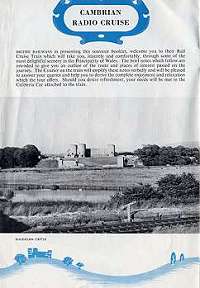
Forthcoming events
June 2010
26-27 June. Llangollen Railway Heritage Railcar Gala. An intensive service with the resident railcars and a special visitor plus the steam autotrain.
July 2010
Friday 16 July Excursion Compass Tours to EDINBURGH (via WCML) Picks up: Hereford, Leominster, Ludlow, Craven Arms, Shrewsbury, Gobowen, Wrexham General, Chester, Frodsham & Warrington Bank Quay Expected to be hauled by class 67s.
24-25 July. Llangollen Railway Ivor the Engine weekend with a return visit from the Welsh engine for a fun weekend. Includes Ivor the Engine in Concert on Saturday evening.
26-30 July: Cambrian Steam: 44871 Machynlleth - Porthmadog or Pwllheli and return.
Wednesday 28 July Conwy Valley Steam: Railway Touring Company. The Welsh Mountaineer Preston - Blaenau Ffestiniog.
31 July-1 August. Llangollen Railway 1960s weekend. Intensive service with a mix of steam, diesel and railcars with opportunity to appear in period dress.
August 2010
2-30 August, Mondays - Fridays only: Cambrian Steam: 44871 Machynlleth - Porthmadog or Pwllheli and return.
7-15 August. Llangollen Railway Day out with Thomas (again) the summer time visit by No.1 and friends.
Sunday 8 August Excursion Compass Tours to SKIPTON & KEIGHLEY (out via Bentham, return S&C + Shap) Picks up: Holyhead, Llanfairpwll, Bangor, Llandudno Junction, Colwyn Bay, Rhyl, Flint, Chester, Frodsham & Warrington Bank Quay. Expected to to be hauled by a class 67.
Sunday 8 August Steam on the Coast. Railway Touring Company. The North Wales Coast Express. Liverpool - Holyhead
Wednesday 11 August Conwy Valley Steam: Railway Touring Company. The Welsh Mountaineer Preston - Blaenau Ffestiniog.
Wednesday 18 August Conwy Valley Steam: Railway Touring Company. The Welsh Mountaineer Preston - Blaenau Ffestiniog.
Sunday 22 August Steam on the Coast. Railway Touring Company. The North Wales Coast Express. Liverpool - Holyhead
Wednesday 25 August Conwy Valley Steam: Railway Touring Company. The Welsh Mountaineer Preston - Blaenau Ffestiniog.
Monday 30 August Excursion Compass Tours to DURHAM + optional add-on tour via Hartlepool to Newcastle (routes covered include Cumbrian Coast, Tyne Valley, ECML, Aire Valley & Hellifield to Carnforth) Picks up: Crewe, Hooton (after runnning round), Ellesmere Port, Frodsham, Warrington Bank Quay, Wigan North Western, Preston, Lancaster & Carnforth This train is booked to feature D1015 Western Champion throughout.
See the Calendar page for more details.
Looking back: the days of the Land Cruise
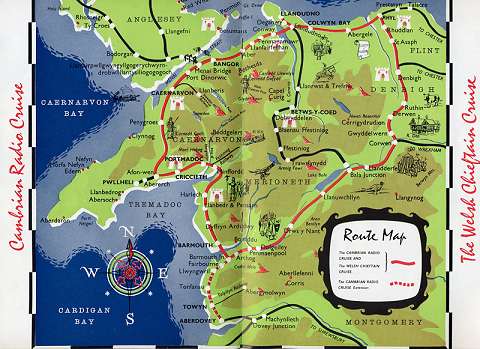
Introduction by Charlie Hulme
I am away on holiday this week, and unable to compile the latest news, so I thought it was time to show some of the results of an appeal made some time ago for information about the various Land Cruise trains which graced the rails of North Wales in the 1950s. Special thanks are due to John Powell, John Wilkinson and Mark Hambly for their contributions.
The first Cruise train operated in 1951, at the time of the Festival of Britain, and was christened the 'Festival Land Cruise.' Their subsequent history, until their final season in 1961, is somewhat complex: various variations in the route were tried, and the train had various names, but the principle was a circular run, with an assortment of comfortable coaches, some of which had been built before the war for various luxury services such as the 'club trains' for wealthy commuters to Manchester and Liverpool. There was the Cambrian Radio Cruise, North Wales Radio Land Cruise, North Wales Radio Cruise and the Welsh Chieftain, all with special headboards.
From 1958 the Rhyl train featured an observation car, no. 280, which had once run in the 'Devon Belle' Pullman service as Car 13. When the Land Cruise finished, this vehicle went to the Scottish Region for use on the Kyle of Lochalsh line. Later bought by preservationists, it can be found on the Paignton and Dartmouth Steam Railway. (A sister vehicle, car 14, which went to the USA has recently been repatriated and restored for the Swanage Railway.)
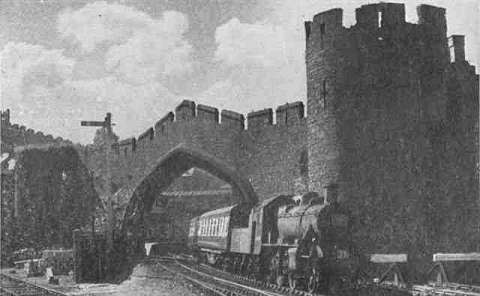
A commentary and a refreshment service were provided, and a lunch break at one of the resorts on the journey. John Powell's journey in 1959, chronicled below, followed the original route from Rhyl with a stop at Barmouth. Haulage was by an LMS-design Class 2 2-6-0 until 1958, when it was decided that the more powerful Class 4 4-6-0s should be used in future. Another train operated from Llandudno, running to Aberdovey rather than Barmouth.
In 1961 the Corwen to Denbigh line was slated for complete closure (although it clung on until 1965) and passenger excursions were disallowed, thus breaking the circular route. Later the Rhyl to Denbigh, Ruabon to Barmouth Junction and Afon Wen to Bangor routes came under the axe, and today no circular route is possible in North Wales without making use of a narrow-gauge line and/or a bus or part of the journey.
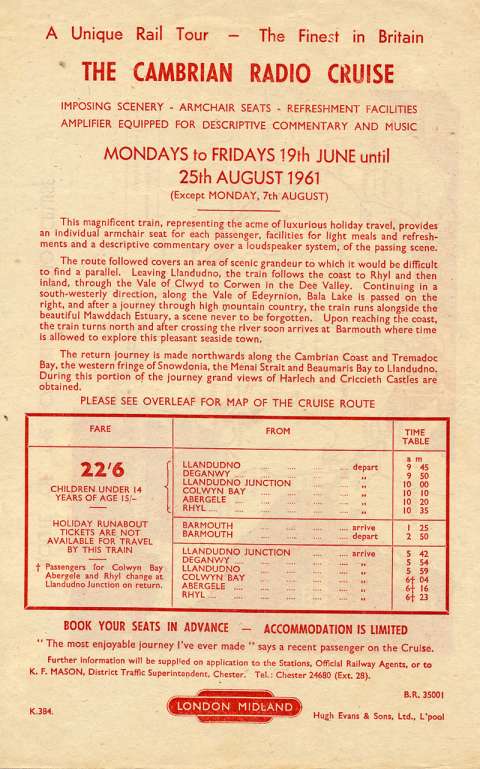
Land Cruise though North Wales - by John Powell
This article was first published in the October 1982 issue of the long-defunct journal North-West Railway Enthusiast - we reproduce it here with John's kind permission.
The morning of June 19th 1957 was very bright as I arose at 7.30 am. Just the sort of day, I thought, to have a rail trip on the 'North Wales Land Cruise' which had just commenced for the season from June to September. First introduced in 1951, they soon proved very popular with holidaymakers, and of course the local residents.
Arriving at Rhyl station at 9.10 am, I was very fortunate to find that there were a few vacant seats on the train as accommodation on the train was limited, and usually seats should be booked in advance. The train was waiting in the bay platform at the west end, and consisted of six coaches of the open saloon type with arm chairs. Motive power for the journey of over 150 miles of mostly single track was to be provided by Standard Class 4MT 4-6-0 No. 75004. An observation of Rhyl locomotive depot showed 2-6-2T No. 41276, ex L & Y 0-6-0 No. 52162, 4-4-0 2P No. 75039, which was to haul the second Land Cruise train after it had arrived from Llandudno. Passing through the station on an up freight was Stanier Class 5MT no. 44800.
Shortly after 9.40 am, we commenced our journey, and were soon passing the on our right the Marine Lake which had a miniature railway running around it, trains being hauled by four locally-built engines. After we had crossed the iron bridge that spans the River Clwyd, we headed south at Foryd Junction, along the Denbigh branch which ran through the beautiful Vale of Clwyd.
The 700-year-old castle of Rhuddlan could be seen on our left, and the Cathedral of St Asaph was soon passed on our right. After passing Trefnant, the branch line from Chester & Mold (opened in 1869) was seen joining us on our left, ex L & Y 0-6-0 no. 52119 was outside the the locomotive depot as we entered Denbigh station. Here we crossed a local train to Rhyl headed by Class 2P 4-4-0 No. 40580.
After leaving Denbigh, we had a fast downhill run for five miles or so, through the closed station of Llanrhaiadr, and started to climb until very soon we arrived at the small station of Ruthin, and it was here that all passenger trains terminated from February 1953.
Beyond Ruthin the line, which was used for freight traffic, ran through some very scenic countryside; after climbing a gradient of 1 in 50, the County of Merioneth was entered. The line then ran down again to cross the River Dee, and we came to a booked water stop at Corwen to allow the tender of 75034 to be topped up.
Leaving Corwen, the River Dee could be seen alongside us as the train passed through Llandeilo and Bala Junction, where I caught a glimpse of the line to Blaenau Ffestiniog on the right. The beautiful four mile long lake of Bala was passed on the right, the calmness having attracted quite a few fishermen. A steady climb of 1 in 60 followed and it was little effort to our 4-6-0 which was in very good condition. Cader Idris mountain (2928 ft) was to be seen as the train began to descend the winding gradient of 1 in 51, and on to Cambrian metals as we entered Penmaenpool. Here we crossed a Barmouth to Ruabon train headed by GWR 2-6-0 no. 6380.
With Penmaenpool now behind us, the yellow sands of the Mawddach estuary were soon seen below us as we entered Barmouth Junction, where we joined the line from Aberystwyth, and went slowly over the lengthy estuary bridge. and through a short tunnel into Barmouth station. where we could spend one and a half hours to look around the town or relax on the sands. I settled myself down to chicken sandwiches on one of the station's chocolate-coloured iron seats.
Observation for one hour was very interesting, a northbound freight was headed by Standard class 2 2-6-0 no. 78007, and 'Manor' class 4-6-0 no. 7801 was on a Pwllheli to Ruabon train. Standard class 2 2-6-0 78005 was on a local to Machynlleth, a double-headed freight headed southbound behind GWR 0-6-0 nos. 2204 and 2235, and the second Land Cruise train arrived behind 4-6-0 no. 75039.
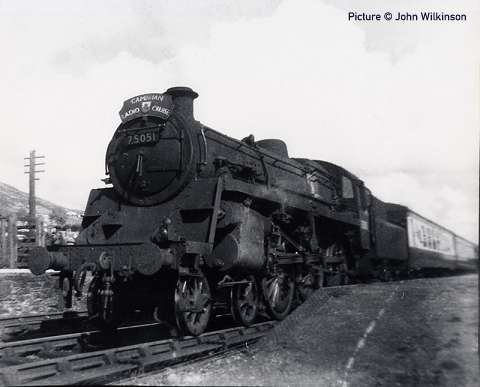
Our departure from Barmouth was slightly delayed, as an elderly lady had "lost" her husband, who had, we found out later, been trying to discover a shop that sold his particular brand of tobacco. Six minutes later we were heading northwards, and soon passed Harlech Castle towering high above us, through the stations of Penrhyndeudraeth and Minffordd, and on toward Portmadoc, where we had a wonderful view of the Snowdon range of mountains. At that moment, I was thinking what a pity it was that we could not see the mountain railway which starts at Llanberis and climbs to the peak of Snowdon (3560 ft).
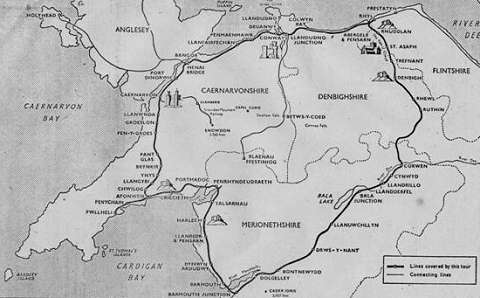
At the seaside resort of Criccieth, where we could see the castle to our left, high on a hill, the countryside was flat as 75034 clattered on towards thr remote station of Afonwen. Here we passed Standard 2-6-4T no. 80087 on a parcels train. After leaving Afonwen, we were back on LNWR metals as we branched away from the Cambrian line that ran to Pwllheli. A long climb of 1 in 58 followed as we passed through Chwilog towards the summit of Pant Glas, and then descended at 1 in 45 to 1 in 70 after passing Groeslon, and on through Llanwnda and Dinas Junction. The single track from Llanberis (for Snowdon) was to be seen on our right, and the Castle of Caernarfon loomed up on our left as we ran under the city walls and came to a water stop in Caernarfon station. 2-6-2T no. 41200 was on shunting duties, and 0-6-0 no. 44445 had arrived with a small freight train.
With Caernarfon station now behind us, we headed eastwards along the Menai Straits, where yachts could be seen, past Port Dinorwic, and ver soon for a brief new of the Britannia Tubular Bridge (later destroyed by fire on May 23rd 1970.) We came to a signal halt at Menai Bridge to allow a London to Express headed by a 'Royal Scot' 4-6-0 to pass through on the main line, then after negotiating the crossing at the east end of the station, 75034 opened up for a fast run to Bangor. After passing through Belmont Tunnel, we came into Bangor station, passing the locomotive depot on the right with its 2-6-2Ts & 2-6-4Ts simmering in the afternoon sun, then on into open countryside, and through Llanfairfechan at a steady 60 mph. The quarry at Penmaenmawr could be seen as we entered the station, and it was here in the early hours of August 27th, 1950, that 'Royal Scot' class 4-6-0 No. 46119 Lancashire Fusilier, heading the up 'Irish Mail' packed with holidaymakers from Ireland, crashed into a light engine, 2-6-0 'crab' no. 42885. Six people were killed and five were badly injured.
We started to slow down on the approach to Conway, past the historic castle on our left, and after crossing the historic tubular bridge over the Conway estuary, a brief view on the locomotive depot was seen before we entered Llandudno Junction station. Here 0-6-0 no. 44389 was on shunting duties, and 2-6-2T no. 40133 was waiting to take a local train through the very picturesque Conway valley to Betws-y-Coed. This branch line could be seen on our right as we very slowly started on the last lap of our journey to Rhyl. After passing a freight train held at signals, the regulator of our 4-6-0 was opened up, and Colwyn Bay was passed at a good speed. Hundreds of holidaymakers could be seen on the sands to our left enjoying ths sunshine, whilst we were plunged into the darkness of Llandulas tunnel, and on past Gwrych Castle to our right contrasting strangely with the holiday caravans to our left as we entered the small station of Abergele & Pensarn. On the 20th August 1868, this station was the scene of the worst accident on the Chester & Holyhead Railway. A down freight had just reached the top of the incline at Llandulas, when a number of wagons broke free and rolled back along the main line for three miles, straight into an express that had just entered the station. As a result, thirty-four lives were lost.
The Denbigh branch line, where we commenced our journey, was to be seen on the right as we began to slow down on the approach to Rhyl, and came to a gentle halt at 5.43 pm, and sorry that the journey had to end after such an enjoyable day out. The locomotive depot was well stocked with an assortment of 0-6-0s, 2-6-4Ts, 4-4-0s, and two Stanier class 5s which had worked in on excursions. A Manchester to Llandudno express, hauled by Stanier class 5MT no. 45144 was entering the station as I handed in my ticket and headed home for tea.
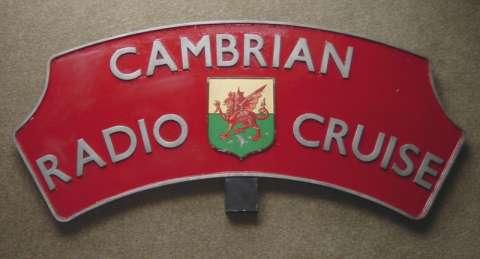
The Western Region's version
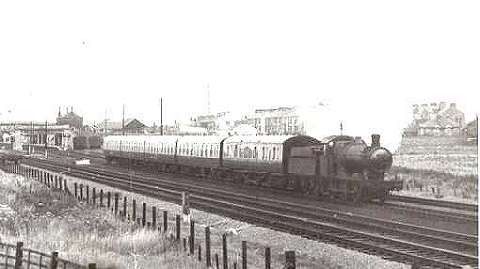
There was also, from 1954, a Western Region Land Cruise intended for Cambrian Coast holidaymakers, which started from Pwllheli and ran round the circle in the opposite direction. (The Cambrian lines were later transferred to the London Midland region.) Like the London Midland version, this was worked by the same locomotive throughout, but most of the ex-GWR locos used on the Cambrian had outside cylinders, and were too wide for the platforms and LMR stations; the only loco that could be used was basically a freight engine, the Collett '2251' class 0-6-0, as seen in the picture, which had inside cylinders. Later, BR standard 2-6-0s appeared on the Cambrian and could be used. This train did not feature curious old coaches; the picture shows four British Railways Mk1 vehicles which were the height of modernity at the time.
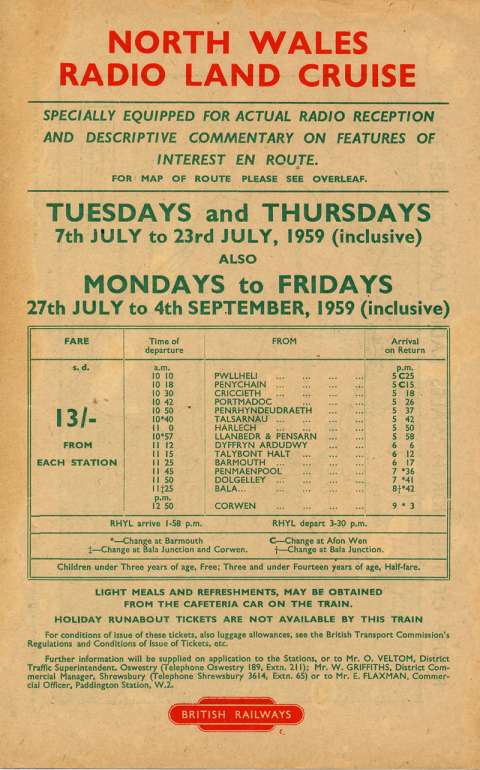
Land Cruise Sources and notes
The late Bill Rear told the story of the Land Cruise in at least two of his books: Railways Along the Clwyd Valley: Corwen to Rhyl (Foxline, 1993) p.27-28, and From Chester to Holyhead: the Branch Lines (OPC, 2003) p. 245-250. Both are recommended reading for anyone interested in North Wales railways.
Pictures above are from various collections: if you know the copyright owner, please get in touch. A version of John Powell's article with more archive pictures can be found, along with many other nostalgic 'goodies', on the 6G Llandudno Junction shed website.
To plan your own present-day Land Cruise, visit Dave Sallery's Cambrian Rail Cruise pages.
North Wales Coast home page 2010 Archive Previous Noticeboard